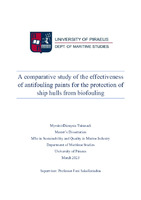A comparative study of the effectiveness of antifouling paints for the protection of ship hulls from biofouling

Master Thesis
Συγγραφέας
Τσιμναδή, Μυρσίνη - Διονυσία
Tsimnadi, Myrsini - Dionysia
Ημερομηνία
2023-03Επιβλέπων
Σακελλαριάδου, ΦανήSakellariadou, Fani
Προβολή/
Λέξεις κλειδιά
Antifouling paints ; Biofouling ; Biocides ; Marine pollution ; Nanoparticles ; Copper-based nanoparticles ; Alternative biocideΠερίληψη
The release of antifouling paints’ biocides into natural waters is a major concern because they may be toxic to non-target marine organisms. Their widespread use over the years led to regulations, resulting to bans or restrictions of their use. Nanoparticles are a rapidly developing sector. Especially, copper-based nanoparticles can be used as biocide in antifouling paints, a very promising application of nanoscience. In this study is monitored the leaching rate of copper from two commercial copper-based antifouling paints with different percentages of Cu2O, 25% and 35%, and from an experimental copper-based antifouling paint with copper oxide nanoparticles as biocide, in a percentage of 5%. Painted aluminum panels are submerged in sea water for 180 days. The release from the panels will be measured with ICP-MS and will be compared. The aim of this study is to propose an alternative biocide, copper oxide nanoparticles, which may be more effective to biofouling, compared to conventional copper, in less quantities. Better results, with less accumulation of copper, less possibilities of toxicity to non-target organisms, so less harm to the marine environment. This is a way to achieve SDGs, especially #14-Life Below Water, one step closer to “conserve and sustainably use the oceans, seas and marine resources for sustainable development”.


